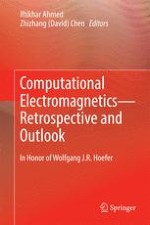2015 | OriginalPaper | Buchkapitel
8. Time Domain Modeling and Simulation from Nanoelectronics to Nanophotonics
verfasst von : Iftikhar Ahmed, Eng Huat Khoo, Erping Li
Erschienen in: Computational Electromagnetics—Retrospective and Outlook
Verlag: Springer Singapore
Aktivieren Sie unsere intelligente Suche, um passende Fachinhalte oder Patente zu finden.
Wählen Sie Textabschnitte aus um mit Künstlicher Intelligenz passenden Patente zu finden. powered by
Markieren Sie Textabschnitte, um KI-gestützt weitere passende Inhalte zu finden. powered by
